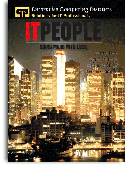IT Automation – Table of Contents
First edition; 208 pages
ISBN: 0-13-019195-7
( by: Anthony F. Tardugno, Thomas R. DiPasquale and Robert E. Matthews )
1. “Lights Out”-Exposed.
Identifying the Components and Complexity of Lights Out Operations. Automation-The Reality Check. The Two-Second Validation.
2. Gap Analysis.
The Gap Model. Your Data Center Today-The Before Picture. The After Picture-The Lights Out Data Center. Needs Analysis. Obtaining Business User Requirements. Working with Applications Development and Data Center Staff. Automation Requirements. Validation of Automation Requirements vs Needs Analysis. The Gap.
3. The Organization.
Prototype IT Organization. Applications Development-by Line of Business (LOB). (New) Technology-Research and Planning. Business Consulting. Enterprise Services. Typical Problems and Issues. Fragmentation. Process Infrastructure. Operations Functions. The Shared vs Distributed Services Dilemma. Automation Initiative-Staffing Issues. High-level Functional Roles in the Automation Project. Team Leader. Enterprise Services. Applications Development. Technology. Business Consulting. User Community.
4. Design and Planning.
Designing the Technical Architecture and Administrative Processes. Technical Architecture Design. Related Selection Criteria. Identifying Vendor and Outsourcing Opportunities. Administrative Process Components. Document and Audit Existing Processes. Production Acceptance Objective and Process. Problem Management Objective and Process. Change Management Objective and Process. Asset Management Objective and Process. Disaster Recovery Objective and Process. Administration Process Design Review. Consolidated Design. Planning-Highlighting Automation Project Nuances. Planning the Automation Initiative.
5. Financial Planning.
Ownership. Choosing Lease versus Buy. Leasing Benefits. Leasing Types and Realities. Cost of Implementation. Ongoing Service. Cost Benefit Analysis. Flat Growth. Efficiency and Performance. The Financial Plan.
6. Communicating and Presenting the Plan.
Building Support Among Key Constituencies. Gathering Information and Getting Organized.
7. Deployment and Continuous Improvement.
Technology Deployment. Assumptions and Risks. Downtime. Communication. Testing. Administrative Process Deployment. Inventory. Summary. Continuous Improvement. Reporting. Evolving. Internal Service Levels. In Closing.
Appendix A: Most Frequently Asked Questions.
People. Processes. Technology. General.
Appendix B: Enterprise (Data Center) Services.
Sample Organization and Management Job Descriptions. Enterprise (Data Center) Services Director. Computer Operations Manager. Network (WAN) Infrastructure Manager. LAN (Desktop) Administration Manager. End User Services Manager. Individual Contributor Roles/Purposes.
Appendix C: Sample IT Operations Internal Service Level Agreement.
Tables.
Table I-1. Methodology and Chapter Mapping. Table 1-1 Data Center Components for Automation Consideration. Table 1-2. Automation Components-Reality Check. Table 2-1. Gap Analysis Steps. Table 2-2. Sample User Questionnaire. Table 2-3. Automation Requirements. Table 2-4. The Sample Gap Matrix. Table 4-1. Sample Disk Capacity Management Requirements. Table 5-1. Leasing Options. Table 5-2. Resource Worksheet. Table 5-3. Staff Reduction Matrix. Table 5-4. Efficiency Example. Table 6-1. Engaging the Enterprise to Build Support. Table 6-2. Presentation Criteria. Table 7-1. Data Center Upgrade Assumptions/Risks Checklist. Table 7-2. Performance Metrics. Table 7-3. Management Metrics. Table 7-4. Methodology and Exercise Review.
Figures.
Figure I-1. Data Center Diagram. Figure I-2 Lights Out Execution Methodology. Figure 3-1 Prototype High-Level IT Functional Organization. Figure 3-2. Prototype IT Functional Org-Enterprise Service Detail. Figure 3-3 Project Team Organizational View. Figure 4-1. Technical Solution. Figure 4-2. Technology Design Process. Figure 4-3 Administrative Process Reengineering and Technical Design. Figure 4-4. Production Acceptance Process Flow. Figure 4-5. Problem Management Process Flow. Figure 4-6. Change Management Process Flow. Figure 4-7. Asset Management Process Flow. Figure 4-8. Administrative Process Reengineering and Technical Design. Figure 4-9. Sample Automation Project Plan. Figure 7-1. Sample Automation Project Plan-Technical Automation Deployment. Figure 7-2. Sample Automation Project Plan-Administrative Process Deployment. Figure 7-3. Change Management Process Flow. Figure B-1. Sample Personnel IT Organization Chart.
Index.

















